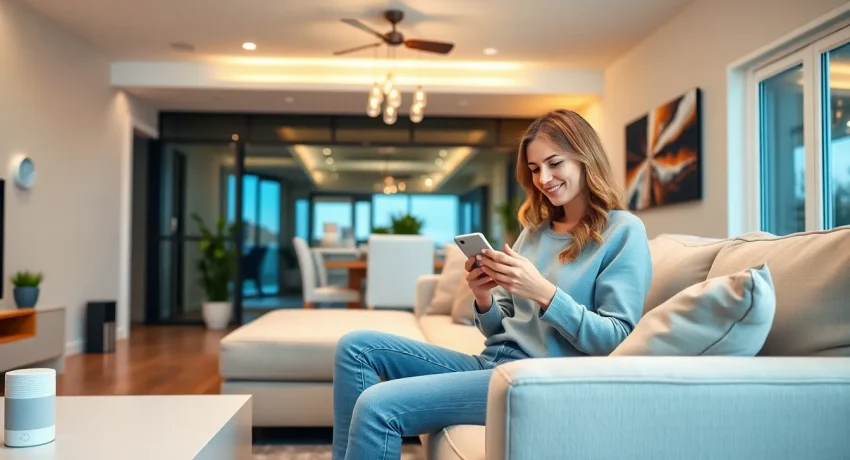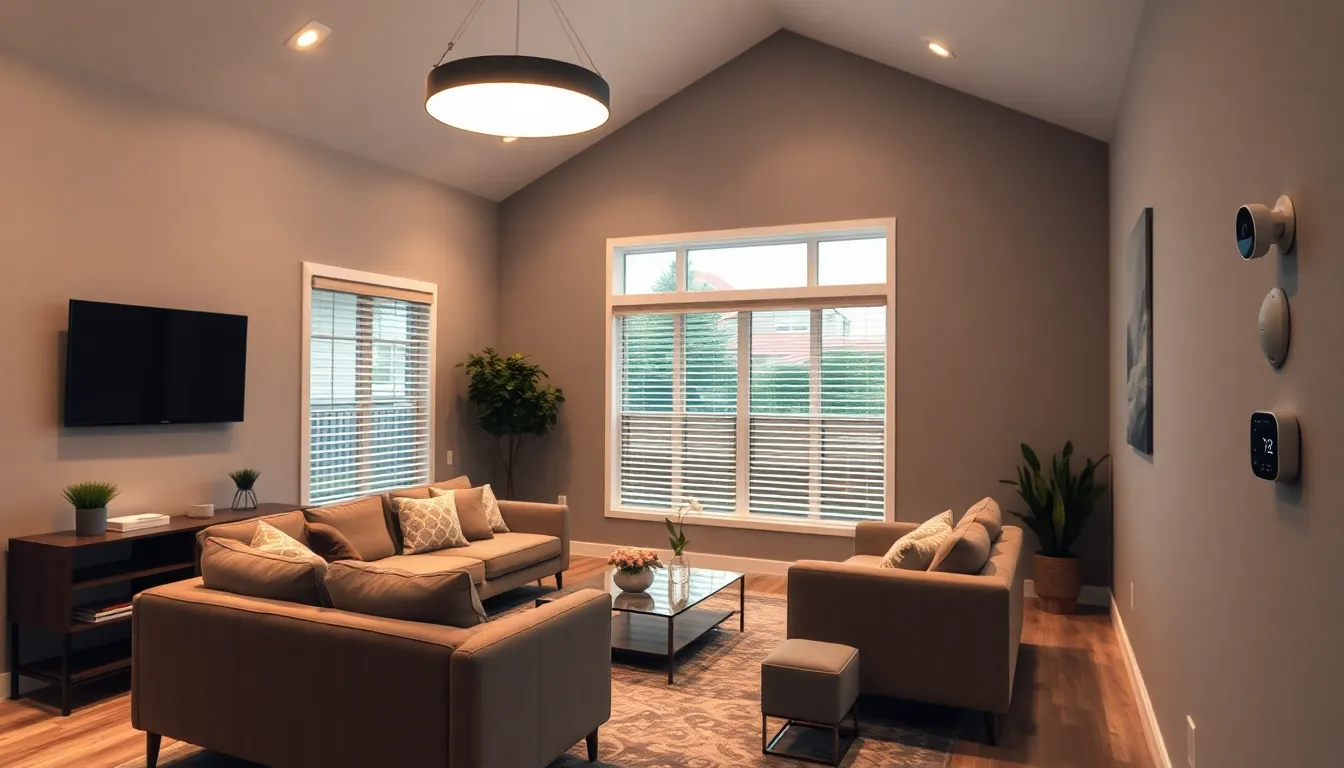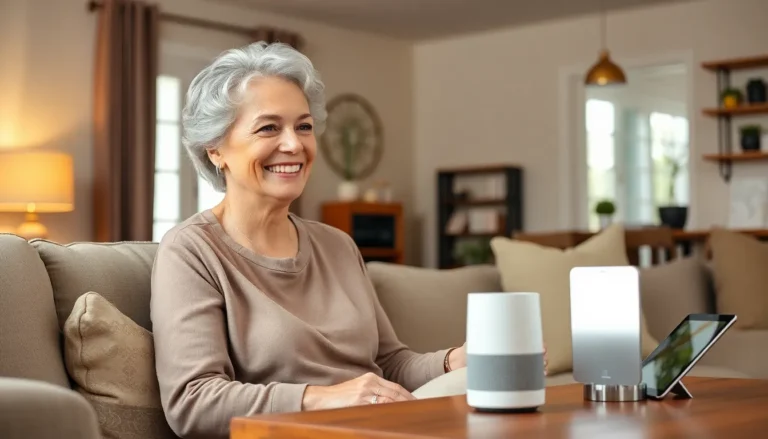Table of Contents
ToggleImagine walking into your home and having it greet you like an old friend. With home automation systems, this dream becomes a delightful reality. These smart technologies transform everyday tasks into effortless experiences, allowing homeowners to control lighting, security, and even coffee makers—all from their smartphones. Who wouldn’t want to turn their home into a personal assistant that can’t spill coffee?
Home automation isn’t just about convenience; it’s about enhancing lifestyle and security. Picture this: you’re snuggled up on the couch, and with a simple voice command, the lights dim, the thermostat adjusts, and your favorite playlist fills the air. It’s like living in a sci-fi movie, but without the flying cars. As technology advances, the options for creating a smart home are endless, making it easier than ever to embrace the future.
Overview of Home Automation Systems
Home automation systems integrate technology to streamline household operations. These systems enhance daily life by providing centralized control over various home elements.
Definition and Purpose
Home automation refers to the use of technology to manage and monitor home systems remotely. The primary purpose involves increasing convenience and efficiency in managing environments. Homeowners control tasks from a smartphone, tablet, or voice assistant, allowing for seamless operation of lighting, security, and appliances. Automated systems also promote energy efficiency by optimizing usage patterns, which leads to cost savings and reduced energy consumption.
Benefits of Home Automation
Numerous benefits arise from adopting home automation systems. Increased security is a significant advantage, with smart locks and surveillance cameras offering real-time monitoring. Enhanced convenience allows users to adjust settings with simple voice commands or scheduled routines. Energy management becomes more efficient through automated lighting and thermostat adjustments. Improved accessibility addresses the needs of individuals with mobility challenges, enabling everyone to control their environment easily. Lastly, heightened property value becomes evident as prospective buyers often seek homes equipped with smart technology.
Types of Home Automation Systems
Home automation systems encompass various types designed to increase convenience and efficiency for homeowners. Each system serves specific functions that enhance daily living.
Smart Lighting
Smart lighting systems allow users to control their home’s illumination remotely. These systems enable scheduling for lights, adjusting brightness levels, and changing colors through mobile apps. Energy efficiency improves significantly, with smart bulbs consuming less power than traditional options. Automation can also trigger lights based on occupancy, enhancing security and energy conservation. Integrating smart lighting with voice assistants streamlines management, making daily routines more enjoyable and easy.
Climate Control Systems
Climate control systems include smart thermostats that optimize home heating and cooling. Users can program schedules to align with their routines, resulting in energy savings. Remote access provides homeowners precise control over temperature settings from anywhere using mobile devices. Smart climate systems often learn individual preferences, adjusting automatically to maintain comfort. Integration with weather forecasts enhances performance, ensuring ideal conditions throughout the day.
Security and Surveillance
Security and surveillance systems feature smart locks, cameras, and alarm systems for comprehensive protection. Homeowners can monitor real-time feeds from their smartphones, ensuring safety no matter their location. Notifications alert users to unexpected activity, allowing for prompt responses. Automated locks provide keyless entry options, enhancing convenience and security. Combining surveillance with motion sensors creates a robust approach to home security, deterring potential threats effectively.
Key Components of Home Automation
Home automation systems consist of several key components that enable seamless integration and control of various home functions. Understanding these elements is essential for creating a smart and efficient living environment.
Sensors and Actuators
Sensors detect changes in the environment, monitoring conditions like temperature, motion, and humidity. For example, motion sensors trigger lights to turn on when someone enters a room. Actuators respond to signals from controllers, adjusting physical devices such as blinds or doors. Together, these components create a responsive home environment that enhances comfort and security.
Controllers and Hubs
Controllers manage the communication between various devices within a home automation system. Smart hubs centralize control by connecting different devices, enabling homeowners to manage them from a single interface. With a hub, users can automate routines, such as setting lights to turn on at sunset. These centralized systems streamline operations, making home management user-friendly.
User Interfaces
User interfaces allow homeowners to interact with their automation systems easily. Mobile applications provide a convenient way to control devices remotely, whether adjusting thermostat settings or locking doors. Voice-activated assistants also enhance usability, allowing users to issue commands verbally. Intuitive interfaces lead to efficient management of home systems, enhancing the overall experience.
Popular Home Automation Technologies
Home automation technologies offer diverse solutions for increasing convenience and efficiency in households. Understanding these technologies helps homeowners make informed decisions.
Z-Wave and Zigbee
Z-Wave operates on low-energy radio waves, targeting short-range communications between devices. Many homeowners appreciate its reliability for controlling lights, locks, and sensors. Zigbee serves a similar purpose, functioning on a mesh network that enables devices to communicate efficiently. It supports various devices, including thermostats and smart plugs, enhancing compatibility. Both technologies feature strong security protocols, helping to protect user data and maintain privacy.
Wi-Fi and Bluetooth
Wi-Fi allows numerous devices to connect directly to the home network, providing high-speed communication without the need for a hub. Smart appliances, cameras, and speakers often utilize Wi-Fi for seamless integration and remote access. Bluetooth, while limited in range, offers simplicity and low energy consumption, making it ideal for personal devices like smart locks and health monitors. Users value its quick pairing process and straightforward setup, promoting user-friendly experiences.
Cloud-Based Solutions
Cloud-based solutions enable users to control home automation systems remotely via the internet. By utilizing cloud services, homeowners can access their devices from anywhere, ensuring peace of mind. Data from devices syncs in real-time, allowing for quick monitoring and updates. Many cloud platforms support smart home ecosystems, connecting devices regardless of brand, which boosts compatibility. Homeowners enjoy the convenience of managing systems through mobile apps or web interfaces.
Conclusion
Home automation systems represent a significant leap in modern living. They offer unparalleled convenience and security while enhancing overall lifestyle quality. With the ability to control everything from lighting to climate with just a few taps or voice commands, homeowners can enjoy a seamless experience that saves time and energy.
As technology evolves, the potential for smart homes continues to expand. Increased property value and improved accessibility make these systems an attractive investment for anyone looking to upgrade their living space. Embracing home automation not only simplifies daily tasks but also creates a more comfortable and secure environment for everyone.





